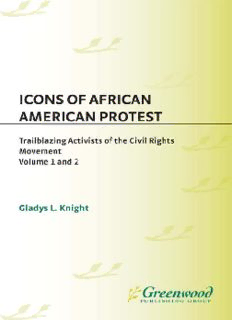
Icons of African American Protest: Trailblazing Activists of the Civil Rights Movement PDF
Preview Icons of African American Protest: Trailblazing Activists of the Civil Rights Movement
ICONS OF AFRICAN AMERICAN PROTEST RecentTitlesin GreenwoodIcons IconsofHorrorandtheSupernatural:AnEncyclopediaof OurWorstNightmares EditedbyS.T.Joshi IconsofBusiness:AnEncyclopediaofMavericks,Movers,andShakers EditedbyKateriDrexler IconsofHipHop:AnEncyclopediaoftheMovement,Music,andCulture EditedbyMickeyHess IconsofEvolution:AnEncyclopediaofPeople,Evidence,andControversies EditedbyBrianRegal IconsofRock:AnEncyclopediaoftheLegendsWhoChangedMusicForever ScottSchinderandAndySchwartz IconsofR&BandSoul:AnEncyclopediaoftheArtistsWhoRevolutionized Rhythm BobGulla AfricanAmericanIconsofSport:Triumph,Courage,andExcellence MatthewC.Whitaker IconsoftheAmericanWest:FromCowgirlstoSiliconValley EditedbyGordonMorrisBakken IconsofLatinoAmerica:LatinoContributionstoAmericanCulture RogerBruns IconsofCrimeFighting:RelentlessPursuersofJustice EditedbyJeffreyBumgarner IconsofUnbelief:Atheists,Agnostics,andSecularists EditedbyS.T.Joshi WomenIconsofPopularMusic:TheRebels,Rockers,andRenegades EditedbyCarrieHavranek IconsofTalk:TheMediaMouthsThatChangedAmerica DonnaL.Halper ICONS OF AFRICAN AMERICAN PROTEST Trailblazing Activists of the Civil Rights Movement VOLUME 1 Gladys L. Knight GreenwoodIcons GREENWOODPRESS Westport,Connecticut • London LibraryofCongressCataloging-in-PublicationData Knight,GladysL.,1974– IconsofAfricanAmericanprotest:trailblazingactivistsofthecivilrightsmovement/ GladysL.Knight. p.cm. Includesbibliographicalreferencesandindex. ISBN978-0-313-34062-8((set):alk.paper)—ISBN978-0-313-34063-5((vol.1):alk.paper)— ISBN978-0-313-34064-2((vol.2):alk.paper) 1.AfricanAmericancivil rightsworkers—Biography. 2.Civilrights workers—UnitedStates— Biography.3.AfricanAmericans—Civilrights—History.4.AfricanAmericans—Civilrights— History.5.Civilrightsmovements—UnitedStates—History.6.Politicalactivists—UnitedStates— History.I.Title. E185.96.K562009 323.09202—dc22 [B] 2008034739 BritishLibraryCataloguinginPublicationDataisavailable. Copyright(cid:2)C 2009byGladysL.Knight Allrightsreserved.Noportionofthisbookmaybe reproduced,byanyprocessortechnique,withoutthe expresswrittenconsentofthepublisher. LibraryofCongressCatalogCardNumber:2008034739 ISBN:978-0-313-34062-8(set) 978-0-313-34063-5(Vol1) 978-0-313-34064-2(Vol2) Firstpublishedin2009 GreenwoodPress,88PostRoadWest,Westport,CT06881 AnimprintofGreenwoodPublishingGroup,Inc. www.greenwood.com PrintedintheUnitedStatesofAmerica Thepaperusedinthisbookcomplieswiththe PermanentPaperStandardissuedbytheNational InformationStandardsOrganization(Z39.48–1984). 10 9 8 7 6 5 4 3 2 1 Contents ListofPhotos vii SeriesForeword ix Preface xi Acknowledgments xv Introduction:IconsandProtestorsoftheTwentiethCentury xvii ChronologyofAfricanAmericanProtest xxiii Volume1 EllaBaker 1 ElaineBrown 27 StokelyCarmichael 53 AngelaDavis 79 W.E.B.DuBois 105 JamesFarmer 131 LouisFarrakhan 155 MarcusGarvey 181 FannieLouHamer 207 DorothyHeight 233 JesseJackson 259 MartinLutherKing,Jr. 285 vi Contents Volume2 SpikeLee 311 JohnLewis 337 MalcolmX 365 ThurgoodMarshall 391 HueyP.Newton 417 RosaParks 443 A.PhilipRandolph 467 AlSharpton 493 IdaB.Wells-Barnett 519 RoyWilkins 545 RobertF.Williams 571 WhitneyYoung 597 Appendix1:ExecutiveOrder8802 623 Appendix2:ExecutiveOrder9981 625 Appendix3:SelectedExcerptsfromtheCivilRightsActof1964 627 Appendix4:SelectedExcerptsfromtheVotingRightsActof1965 637 Appendix5:ExcerptfromtheBlackPantherPartyTenPoint PlatformandProgram(October1966) 641 Appendix6:IconsinTheirOwnWords 643 Glossary 657 Bibliography 663 Index 665 Photos Ella Baker (page 1), between 1942 and 1946. Courtesy of the Library of Congress. Black Panther Party members, leader Elaine Brown (page 27; center) and co- founderHueyP.Newton(right),posewiththeirlawyerCharlesR.Garry (left) on the campus of Yale University, New Haven, Connecticut, probablyinApril1970.PhotobyDavidFenton/GettyImages. StokelyCarmichael(page53),1966.CourtesyoftheLibraryofCongress. PosterofAngelaDavis(page79),1971.CourtesyoftheLibraryofCongress. W.E.B.DuBois(page105),between1930and1950.CourtesyoftheLibrary ofCongress. James Farmer (page 131) at Foley Square in New York, speaking at a memorial for four African American girls killed in a church bombing in Birmingham,Alabama,1963.CourtesyoftheLibraryofCongress. Louis Farrakhan (page 155) told a Washington news conference he has no doubt that Libyan leader Moammar Khadafy was sincere in offering to help train and arm black Americans for an uprising against the U.S. government. ‘‘I cannot accept the carnal weapons of this world,’’ Farrakahnsaid,1985.APPhoto/ScottStewart. MarcusGarvey(page181),1924.CourtesyoftheLibraryofCongress. Fannie Lou Hamer (page 207) at the Democratic National Convention, AtlanticCity,NewJersey,1964.CourtesyoftheLibraryofCongress. DorothyHeight(page233;right)presentstheMaryMcLeodBethuneHuman Rights Award to Eleanor Roosevelt (left) at the council’s silver anniversarylunch,1960.CourtesyoftheLibraryofCongress. viii Photos Jesse Jackson (page 259) surrounded by marchers carrying signs advocating support for the Hawkins-Humphrey Bill for full employment. Courtesy oftheLibraryofCongress. Martin Luther King, Jr. (page 285) delivering a speech at Girard College, Philadelphia,1965.CourtesyoftheLibraryofCongress. Director Spike Lee (page 311) shown on the set of his 1996 film Get on the Bus.CourtesyofPhotofest. Compositeoftwophotographs:bottomphotoshowstheSelmaMontgomery civil rights march, with Dr. Martin Luther King, Jr. (front/center), CorettaScottKing(behindDr.King),andJohnLewis(page337;rightof Mrs. King); top photograph shows five white segregationists, two with confederateflags,1965.CourtesyoftheLibraryofCongress. Malcolm X (page 365) during a rally in Harlem, New York, 1963. Courtesy oftheLibraryofCongress. Thurgood Marshall (page 391) shown in front of the Supreme Court, 1958. CourtesyoftheLibraryofCongress. ABlackPantherposterfeaturingHueyNewton(page417).Textbeneaththis imageread:‘‘Theracistdogpolicemenmustwithdrawimmediatelyfrom ourcommunities,ceasetheirwantonmurderandbrutality.’’Courtesyof theLibraryofCongress. Rosa Parks (page 443) seated toward front of bus, Montgomery, Alabama, 1956.CourtesyoftheLibraryofCongress. A. Philip Randolph (page 467) standing before the statue at the Lincoln Memorial, during the 1963 March on Washington. Courtesy of the LibraryofCongress. AlSharpton(page493)onSaturdayNightLive,2003.CourtesyofPhotofest. IdaB.Wells(page519),1891.CourtesyoftheLibraryofCongress. RoyWilkins(page545),1963.CourtesyoftheLibraryofCongress. RobertF.Williams(page571)livinginexile.LynnPelham/TimeLifePictures/ GettyImages. Whitney Young (page 597) reading a book, 1963.Courtesy of the Library of Congress. Series Foreword Worshipped and cursed. Loved and loathed. Obsessed about the world over. What does it take to become an icon? Regardless of subject, culture, or era, the requisite qualifications are the same: (1) challenge the status quo, (2) influence millions, and (3) impact history. Using these criteria, Greenwood Press introduces a new reference format and approach to popular culture. Spanning a wide range of subjects, vol- umes in the Greenwood Icons series provide students and general readers a port of entry into the most fascinating and influential topics of the day. Ev- ery two-volume title offers an in-depth look at approximately 24 iconic fig- ures, each of which captures the essence of a broad subject. These icons typically embody a group of values, elicit strong reactions, reflect the essence of a particular time and place, and link different traditions and peri- ods. Among those featured are artists and activists, superheroes and spies, inventors and athletes—the legends and mythmakers of entire generations. Yet icons can also come from unexpected places: as the heroine who tran- scends the pages of a novel or as the revolutionary idea that shatters our previously held beliefs. Whether people, places, or things, such icons serve as a bridge between the past and the present, the canonical and the contem- porary. By focusing on icons central to popular culture, this series encour- ages students to appreciate cultural diversity and critically analyze issues of enduring significance. Most importantly, these books are as entertaining as they are provocative. Is Disneyland a more influential icon of the American West than Las Vegas? How do ghosts and ghouls reflect our collective psyche? Is Barry Bonds an inspiring or deplorable icon of baseball? Designed to foster debate, the se- ries serves as a unique resource that is ideal for paper writing or report pur- poses. Insightful, in-depth entries provide far more information than conventional reference articles but are less intimidating and more accessible than a book-length biography. The most revered and reviled icons of
Description: